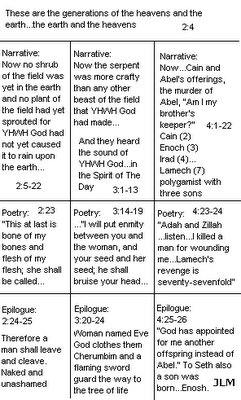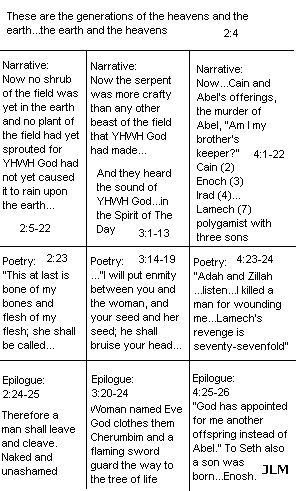 The key to seeing what is most important to the author is noticing the compositional strategy of the book. Most of the books in Genesis follow the following pattern: heading (“these are the generations of…”), narrative, poetry, epilogue. Actually Sailhamer, as mentioned in my earlier post, “The Way of Wisdom: The Canon and Cessation,” notes that narrative, poetry, epilogue is the compositional strategy of the whole of Genesis and the whole of the Torah. In this strategy the key is the poetry. The difference between this book and most of those in Genesis is that the pattern of narrative, poetry, epilogue takes place thrice.
The key to seeing what is most important to the author is noticing the compositional strategy of the book. Most of the books in Genesis follow the following pattern: heading (“these are the generations of…”), narrative, poetry, epilogue. Actually Sailhamer, as mentioned in my earlier post, “The Way of Wisdom: The Canon and Cessation,” notes that narrative, poetry, epilogue is the compositional strategy of the whole of Genesis and the whole of the Torah. In this strategy the key is the poetry. The difference between this book and most of those in Genesis is that the pattern of narrative, poetry, epilogue takes place thrice.
Genesis 2:4 is the heading for the second book: “These are the generations of the heavens and the earth when they were created, in the day that YHWH God made the earth and the heavens.” It is worth noting, since this is a common structure in Genesis, that the mention of heavens, earth, earth, heavens is a chiastic pattern. Also the heading is artificially contrived to maintain continuity with the rest of the ten headings in the whole of Genesis. (Ten being a consistently significant number for fullness.) The title does not tell us who the book is about, instead the book is about this person’s descendants. Thus, the first book is about the “descendants” of the heavens and the earth.
Within the narratival sections there is a general pattern. Each one begins with the problem, the response to the problem, and interaction between the person(s) involved and God. In the first panel (Gen 2:5-22) the main problem is that the earth has not yet brought forth vegetation (Gen 1:12) because it had not rained. It is also noted that there was no man, thus no irrigation. God solves these problems one at a time. First with rain, as translated by Lee Irons and Meredith Kline in “The Framework View” in The G3n3s1s Debate, “So a rain-cloud began to arise from the earth and watered the whole surface of the ground.” The word translated “rain-cloud” is only found in Scripture in Job and is found in another ANE language. In Job and the other language it means, “rain-cloud.” (Not to mention that this translation makes sense as the solution to the problem introduced.) The other part is then solved by making man and designating him as the priest who guards or keeps the garden (Gen 2:15). God tells the man not to eat of the tree of knowledge of good and evil (a probationary test) and after making the land animals and birds then makes woman. The act of naming the animals shows Adam’s servant-king power over the creation.
In the second panel (Gen 3:1-13) the problem is the serpent. Adam is the one to blame in the text because he had been given the role of the priest (“guard” the garden). Adam’s response to the problem, however, was not to stand up to the serpent but to buy into his lies. In this panel the interaction between God and man is one of judgment. The picture is that of Judgment Day, or as it is often referred to in Scripture “the day” — thus “And they heard the sound of YHWH God walking in the garden in the Spirit of The Day” (Gen 3:8). Adam and Eve hid because they knew it was The Day “for in The Day that you eat of it you shall surely die” (Gen 2:17). The judgment day motif is complete with the sound of YHWH, which elsewhere in Scripture is described as incredibly loud and similar to that of a huge army. And the Spirit of God, usually translated with the silly “cool” idea of wind, should be identified with the Spirit of God from Gen 1:2 that hovered like a bird over the face of the waters. The response of Adam and Eve to the questioning in the court of judgment was to pass the blame. Adam blamed God and the woman. Eve blamed the serpent. It is not much of a step to Cain’s “Am I my brother’s keeper?” (Gen 4:9).
In the third panel (Gen 4:1-22) the problem is that “Cain brought to YHWH an offering of the fruit of the ground.” Abel’s offering was accepted because it was the firstborn of his flock, but Cain’s offering was not the firstfruits of the ground. And Cain’s sin mastered him as he killed Abel in premeditated murder in the field. Unlike in later Scripture where the death penalty is prescribed for murderers, God spares Cain and protects him. The genealogy offered in this chapter includes several interesting things worth noting. As we have been stressing structure, you should number the genealogy with Lamech as number seven. Cain is number 2, Enoch is number 3, Irad is number 4, etc. Number seven will without a doubt be significant. And Lamech is significant because he shows that sin has escalated out of control to a climax ready for God’s judgment since he has two wives in contrast with the teaching of the first panel of marriage between one man and one woman and is a murderer (this we discover in the poetry). The genealogy is also structurally interesting because Lamech has three sons Jabal, Jubal, and Tubal-cain. Adam also had three sons, Cain, Abel and Seth, and Noah had three sons, Shem, Ham and Japheth.
Most important in this book’s structure is the poetry. In panel one the poetry is Gen 2:23: “This at last is bone of my bones and flesh of my flesh; she shall be called Woman, because she was taken out of Man.” In panel two the poetry is Gen 3:14-19. The most quoted portion of this poem is the protoevangelium: “I will put enmity between you and the woman, and between your offspring and her offspring; he shall bruise your head, and you shall bruise his heel” (Gen 3:15). The poetry in the third panel is Lamech’s curse where he boasts of murdering a young man for striking him and calls for revenge seventy-sevenfold. Unlike Cain, Lamech does not want his family to wait for God’s vengeance but to take unbridled revenge into their own hands if anyone touches him. This is the perfect example of disproprotionate response — Lamech kills a man for hitting him and if anyone kills him in reply he calls for seventy-sevenfold retaliation. Lamech’s words are the anti-gospel. All of this poetry points to Jesus Christ. Jesus is the new Adam and his church is the Woman, bone of his bones and flesh of his flesh. Jesus is the seed (“offspring”) of the woman who bruises the head of the serpent. And Jesus is the one who goes through the curse of death on the cross for our sins and leads us to forgive seventy-sevenfold as he forgives his murderers.
The rest of the text in each panel (the remainer of each chapter) are the epilogues. The first epilogue shows a happy relationship between man and wife without shame. Shame would require clothing in the second panel (first they clothe themselves, but in the epilogue God sacrifices an animal to give them garments of skin). The epilogue also explains the continuing application of the poetry to the life of God’s people (“a man shall leave his father and mother and cleave to his wife, and they shall become one flesh” Gen 2:24). In the second panel, the continuing consequence is being driven from the mountain-garden of fruitfulness (Eden) so that man would not eat of the tree of life and seal himself to continue forever in his fallen estate. The way to the tree of life is through the sword of the circumcision of Christ on the cross. And in the third panel we see the birth of Seth. Seth’s son Enosh would be the heir of Abel as this is the first example of a common practice in Israel (for example Boaz does this in the book of Ruth for Elimelech and his son Mahlon). This is why Enosh is mentioned here: Abel has his heir and the book can conclude on a note of hope with calling upon the name of YHWH.
We could examine these three chapters and note a great many more details. My reflections here owe much to my professors at Westminster Theological Seminary, the works of Meredith Kline, and the commentary of Bruce Waltke. As always I have added my own observations and analysis and any mistakes are my own.

Recent Comments